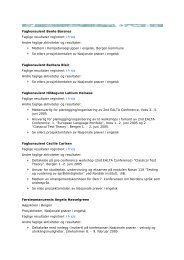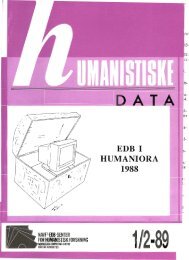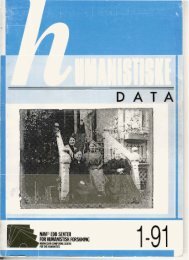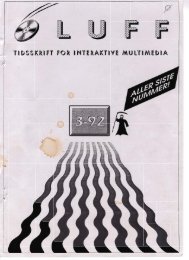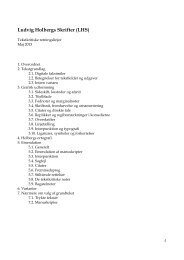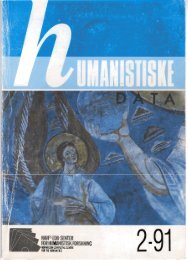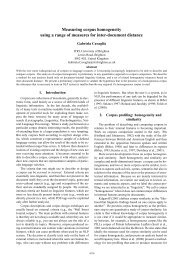Computer-assisted corpus-based text analysis with TATOE
Computer-assisted corpus-based text analysis with TATOE
Computer-assisted corpus-based text analysis with TATOE
Create successful ePaper yourself
Turn your PDF publications into a flip-book with our unique Google optimized e-Paper software.
parse these events and update the knowledge<br />
base used for the Editor’s Workbench application<br />
(for the general con<strong>text</strong> of this work<br />
see Rostek et al., 1994 and Rostek and Moehr,<br />
1994)<br />
• domain specific thesaurus construction: <strong>analysis</strong><br />
of press release messages issued by the<br />
Deutsche Presse Agentur (DPA) for the construction<br />
of a semantic network to support<br />
fact extraction from these messages<br />
• thematic development in encyclopedic reference<br />
<strong>text</strong>s: exploration, determination and<br />
subsequent specification of thematic development<br />
preferences typical of English artist<br />
biographies and archeological site descriptive<br />
<strong>text</strong>s in order to specify the <strong>text</strong> type<br />
specific thematic choices for automatic <strong>text</strong><br />
generation.<br />
For all the above objectives computational support<br />
has been required to structure, compile and edit the<br />
<strong>text</strong> data and to further annotate parts of the <strong>text</strong><br />
corpora and extract linguistically variant<br />
knowledge.<br />
Aiming at supporting such <strong>text</strong> <strong>analysis</strong> tasks as<br />
the ones listed above we have designed and implemented<br />
<strong>TATOE</strong>, a Text Analysis Tool <strong>with</strong> Object<br />
Encoding, the functionalities of which we present<br />
in this paper. Section 3 lists specific requirements<br />
for supporting computationally <strong>corpus</strong>-<strong>based</strong> <strong>text</strong><br />
<strong>analysis</strong> and presents some of the current tools for<br />
this task. Section 4 describes <strong>TATOE</strong> and its main<br />
functionalities. Section 5 provides the technical<br />
characteristics of the tool. Finally, section 6 presents<br />
the future directions of this work and concludes<br />
the paper.<br />
3. Requirements for supporting <strong>text</strong><br />
<strong>analysis</strong> computationally<br />
The general situation in <strong>corpus</strong>-<strong>based</strong> <strong>text</strong> <strong>analysis</strong><br />
can be described as one where particular linguistic<br />
phenomena observed in the <strong>corpus</strong> need to be<br />
interpreted <strong>with</strong>in a theoretical framework. This<br />
interpretation may be an intellectual task typical<br />
of scientific work for <strong>analysis</strong>, understanding and<br />
explanation of <strong>text</strong>s. A tool for semi-automated<br />
support <strong>analysis</strong>, then, needs to provide an integrated<br />
and user-friendly working environment whereby<br />
at least the following are supported:<br />
• compiling and importing one or more <strong>text</strong><br />
corpora<br />
• importing an already existing a – hierarchically<br />
or non-hierarchically – structured<br />
knowledge classification schema<br />
• definition and construction of one’s own<br />
classification schema<br />
• development or usage of one or more classification<br />
schemata for annotation and, thus,<br />
12<br />
knowledge categorization enabling annotation<br />
of <strong>text</strong> segments (words, groups of<br />
words, etc.) according to the schema used<br />
• interactive annotation by mechanisms that<br />
are flexible and easy to use on <strong>text</strong> selections<br />
• enabling work <strong>with</strong> more than one categorization<br />
schemata concurrently, so that the<br />
analyst can work separately <strong>with</strong> different<br />
levels of linguistic description, e.g. morphological,<br />
lexical, syntactic, etc., and at the<br />
same time integrate information from different<br />
schemata (for most <strong>text</strong> <strong>analysis</strong> tasks<br />
integration of different kinds of linguistic<br />
knowledge is a requisite)<br />
• the integration of already existing automatic<br />
tagging/encoding tools for an initial annotation<br />
and enabling work <strong>with</strong> already annotated<br />
corpora, e.g. <strong>with</strong> SGML, PoS<br />
annotation, etc.<br />
• flexibly viewing already encoded <strong>text</strong> segments;<br />
this includes both selecting and arranging<br />
according to different criteria<br />
(frequency of occurrences, encoded category<br />
types, etc.) and presenting information <strong>with</strong><br />
readable layout styles (fonts, colours)<br />
• concordance list presentations<br />
• calculating different statistics for every word<br />
and every annotated <strong>text</strong> segment and this on<br />
the basis of the (hierarchical or non-hierarchical)<br />
relations <strong>with</strong>in the categorization<br />
schema, e.g. frequency of occurrence of<br />
word tokens, word types, schema categories,<br />
or demonstration of how these elements are<br />
distributed in one or all <strong>text</strong>s<br />
• providing solutions or mechanisms for exporting<br />
both annotated and non-annotated<br />
information in different formats, e.g. SGML,<br />
for further processing<br />
• multilingual <strong>text</strong> <strong>analysis</strong>.<br />
Current available tools and programs which may<br />
support the above <strong>text</strong> <strong>analysis</strong> requirements can<br />
be categorized according to <strong>corpus</strong> processing<br />
tools, general <strong>text</strong> <strong>analysis</strong> tools <strong>with</strong> retrieval<br />
capabilities, and annotation tools or programs, i.e.<br />
taggers. To give just a flavour of these consider:<br />
the DTTool for tagging corpora for anaphora<br />
(Aone and Bennett, 1994), the INTEX <strong>corpus</strong><br />
processing system (Silberztein 1994), the COS-<br />
MAS <strong>corpus</strong> storage, maintenance and access system<br />
<strong>with</strong> built-in corpora (al-Wadi, 1994), the<br />
WordCruncher, a flexible PC-<strong>based</strong> <strong>text</strong> retrieval<br />
<strong>corpus</strong> exploration tool (available from IKS,<br />
Bonn), TACT (Bradley,1990) and Lexa (Hickey,<br />
1992) for general <strong>text</strong> exploration <strong>with</strong> presenting<br />
information in the form of concordance lists and<br />
statistical tables, the knowledge extraction tools<br />
KES and GRAAL (as described in (Ogonowski et




